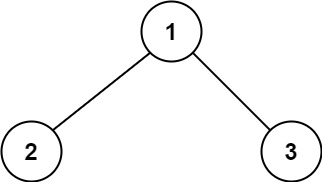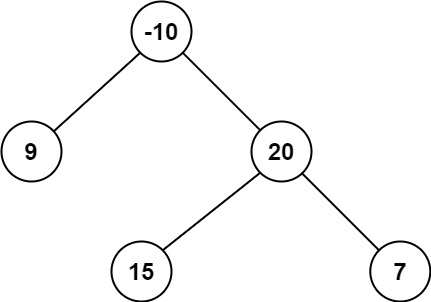A path in a binary tree is a sequence of nodes where each pair of adjacent nodes in the sequence has an edge connecting them. A node can only appear in the sequence at most once. Note that the path does not need to pass through the root.
The path sum of a path is the sum of the node's values in the path.
Given the root of a binary tree, return the maximum path sum of any non-empty path.
Example 1:

Input: root = [1,2,3]
Output: 6
Explanation: The optimal path is 2 -> 1 -> 3 with a path sum of 2 + 1 + 3 = 6.
Example 2:

Input: root = [-10,9,20,null,null,15,7]
Output: 42
Explanation: The optimal path is 15 -> 20 -> 7 with a path sum of 15 + 20 + 7 = 42.
Constraints:
[1, 3*10^4]$.-1000 <= Node.val <= 1000
題目給了一個二元樹根結點 root
定義一個 path 的 sum 代表把在 path 上所有的結點值相加
找出一個樹的 path 所能形成最大 sum,且每個結點在路徑只能出現一次
這個問題的核心在於要如何找出最大值
透過累計的方式我們可以從 root 結點來分析
從 root 拆解出, 從root 結點分岔 + 從 root 點不分岔兩種包含 root 結點方式
而這個問題,可以用DFS 來做探訊
假設不做分岔的方法是 maxSum
累計量 accum = max(accum, root.Val + maxSum(root.left) + maxSum(root.Right))
對包含 root 的樹去找 maxSum(root) = root.Val + Max(maxSum(root.left) , maxSum(root.Right) )
這樣只要走訪完整棵樹即為最大值, 時間複雜度O(n)
參考下圖

package sol
/**
* Definition for a binary tree node.
* type TreeNode struct {
* Val int
* Left *TreeNode
* Right *TreeNode
* }
*/
func maxPathSum(root *TreeNode) int {
if root == nil {
return 0
}
result := root.Val
MaxSum(root, &result)
return result
}
func MaxSum(root *TreeNode, result *int) int {
if root == nil {
return 0
}
leftMax := MaxSum(root.Left, result)
rightMax := MaxSum(root.Right, result)
// choose or not choose
leftMax = Max(leftMax, 0)
rightMax = Max(rightMax, 0)
// split
*result = Max(*result, root.Val+leftMax+rightMax)
return root.Val + Max(leftMax, rightMax)
}
func Max(i, j int) int {
if i > j {
return i
}
return j
}
